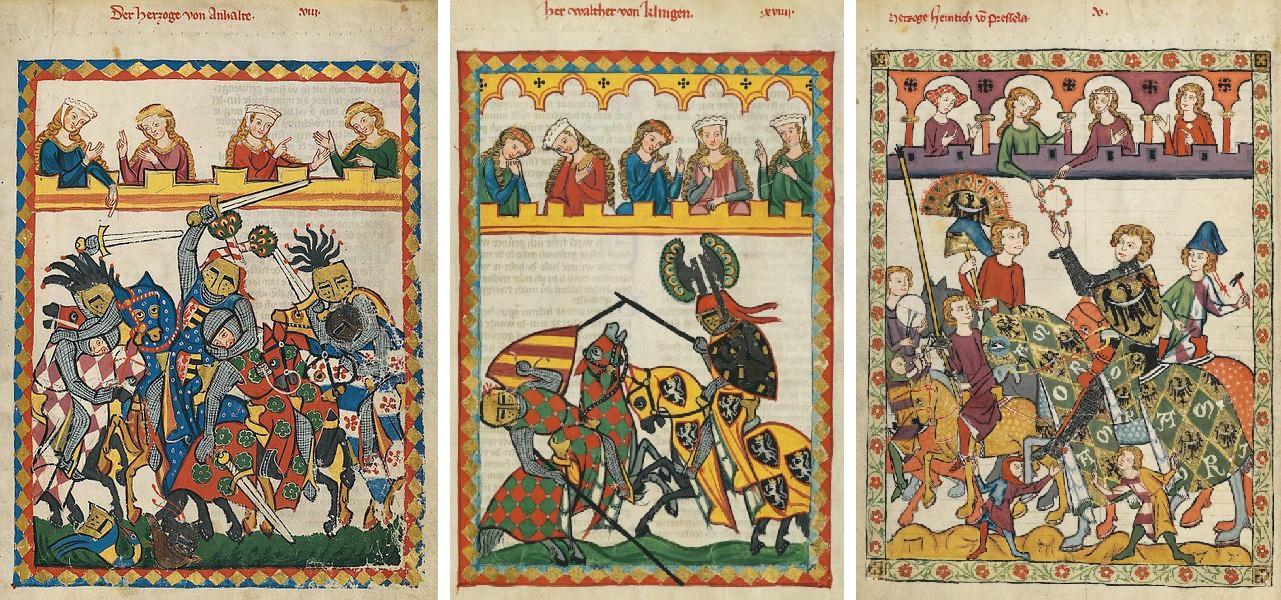The following by Charles Mills (1825) documents interaction between men and women at the first sports tournaments, a tradition from which we derive much of the structure and symbolism of today’s sporting tournaments. Have we moderns lost some of the gynocentrism of the early sports tournaments, or have we added to it? You be the judge. – PW
Ladies were judges of the tournament

The ladies were the supreme judges of tournaments, and if any complaint was raised against a knight, they adjudged the cause without appeal. Generally, however, they deputed their power to a knight, who, on account of this distinction, was called the Knight of Honour. He bore at the end of his lance a ribbon or some other sign of woman’s favour, and with this badge of power he waved the fiercest knights into order and obedience.
The heralds read to the knights the regulations of the sport, and announced the nature of the prize they were to contend for. The dames and maidens sometimes proposed jewels of price, a diamond, a ruby, and a sapphire, as rewards of valour. But the meed of renown was often more military, and the reader of Italian history remembers that at a tournament celebrated at Florence in the year 1468, Lorenzo de’ Medici bore away the prize of a helmet of silver with a figure of Mars as the crest. It was the general wont of tournaments for a vanquished knight to forfeit his armour and horse to his victor.
Knights were led by ladies
The knights then trooped to the listed a plain, with lords, ladies, and damsels, the chivalry and beauty of the country, mounted on gaily-caparisoned steeds and palfreys, whose housings swept the ground. Sometimes a lady fair led the horse of her chosen knight, and in the song of the minstrel the bridle became a golden chain of love. At the day appointed for a merry tournament, in the reign of Richard II., there issued out of the Tower of London, first, three-score coursers, apparelled for the lists, and on every one a squire of honour riding a soft pace.
Then appeared three-score ladies of honour; mounted on fair palfreys, each lady leading by a chain of silver a knight sheathed in jousting harness. The fair and gallant troop, with the sound of clarions, trumpets, and other minstrelsy, rode along the streets of London, the fronts of the houses shining with martial glory in the rich banners and tapestries which hung from the windows. They reached Smithfield where the Queen of England and many matrons and damsels were already seated in richly adorned galleries. The ladies that led the knights joined them; the squires of honour alighted from their coursers, and the knights in good order vaulted upon them.
Knights wore ladies’ favours, who imitated the dress of knights
The tilting armour in which knights were sheathed was generally of a light fabric, and splendid. Its ornaments came under a gentler authority than that of royal constables and marshals. If the iron front of a line of cavaliers in the battle-field was frequently- gemmed with the variously coloured signs of ladies’ favors, those graceful additions to armour yet more beseemed the tournament. Damsels were wont to surmount the helmets of their knights with chaplets, or to affix streamers to their spears, and a cavalier who was thus honoured smiled with self-complacency on the highly emblazoned surcoat of his rival in chivalry.
The desire to please ladies fair formed the very soul of the tournament. Every young and gallant knight wore the device of his mistress, while, indeed, the hardier sons of chivalry carried fiercer signs of their own achievements but they were unmarked by the bright judges of the tourney, for their eyes could only follow through the press their own emblems of love. Nothing was now to be heard but the noise and clattering of horse and armour.
Knights thanked by ladies
Every preux cavalier had by his side a lady bright. The minstrels tuned their harps to the praise of courtesy and prowess, and when the merriment was most joyous, the heralds presented to the ladies the knights who had worthily demeaned themselves. She, who by the consent at her fail companions was called La Royne de la Beaulte et des Amours, delivered the prizes to the kneeling knights. This queen of beauty and love addressed each of them with a speech of courtesy, thanking him for the disport and labour which he had taken that day, presenting to him the prize as the ladies’ award for his skill, and concluding with the wish that such a valorous cavalier would have much joy and worship with his lady.
“The victory was entirely owing to the favor of my mistress, which I wore in my helmet,” was the gallant reply of the knight, for he was always solicitous to exalt the honor of his lady-love. As tournaments were scenes of pleasure, the knight who appeared in the most handsome guise was praised and, to complete the courtesies of chivalry, thanks were rendered to those who had travelled to the lists from far countries.
Source: Charles Mills, The History of Chivalry Or Knighthood and Its Times (1825)